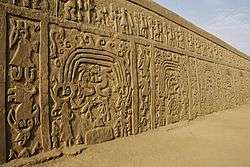Huaca del Dragón
The Huaca del Dragon,[1][2] also called Huaca del Arco Iris is an archeological site located in the Peruvian city of Trujillo, near Chan Chan. It is a large religious monument, administrative and ceremonial center. It is constructed of adobe, with murals decorated with friezes in relief showing human figures and representing a rainbow.

Wall in the Huaca Dragon or Arco Iris.
Description
Upon entering the Huaca a ramp leads to the first level. Figures carved on the walls take the form of a dragon (hence its name). Another ramp, smaller than the first, leads to the second level. This level hosts pits, which were possibly used to store food.[3]
gollark: Because it's useful to nobody?
gollark: And since the definition is entirely free of points ("pointless") it must be good.
gollark: `...` is clearly a very useful combinator, as you can see.
gollark: ```haskell(...) = (.) . (. (.)) . (.) . (. (. (.))) . ((.) .)(...) :: (((b1 -> c1) -> c2) -> b2 -> c3) -> (a1 -> b3 -> c2) -> a1 -> (((a2 -> b1) -> a2 -> c1) -> b3) -> (a3 -> b2) -> a3 -> c3```
gollark: I don't like it. You can barely see the text, since it doesn't contrast with that block there.
See also
- Iperu, tourist information and assistance
- Tourism in Peru
- Huaca del Sol
- Chan Chan
- Huaca Esmeralda
- Chimu
- Chotuna-Chornancap
References
- "(Spanish)Huacas en Trujillo" (PDF). Retrieved December 2, 2012.
- "(Spanish) APROVECHAMIENTO ECONÓMICO DE LOS RECURSOS ARQUEOLÓGICOS DE LA COSTA NORTE DEL PERÚ COMOALTERNATIVA DE CRECIMIENTO DEL PRODUCTO TURÍSTICO". Retrieved December 2, 2012.
- "(Spanish)Huaca del Dragon o Arco Iris". Retrieved December 2, 2012.
Further reading
- Kubler, George. (1962). The Art and Architecture of Ancient America, Ringwood: Penguin Books Australia Ltd., pp. 247–274
External links
- Location of Huaca del Dragón in Trujillo (Wikimapia)
- UNESCO World Heritage Center: Chan Chan
- History Channel Classroom: Chan Chan
- Chan Chan information
- Chan Chan - Chimu's Desert City (Flash)
- Heavy Rains Threaten Ancient City in Northern Peru
- Archaeologists Restore High Adobe Walls in Ancient Chimu City of Chan Chan
| Wikimedia Commons has media related to Huaca Arco Iris. |
This article is issued from Wikipedia. The text is licensed under Creative Commons - Attribution - Sharealike. Additional terms may apply for the media files.